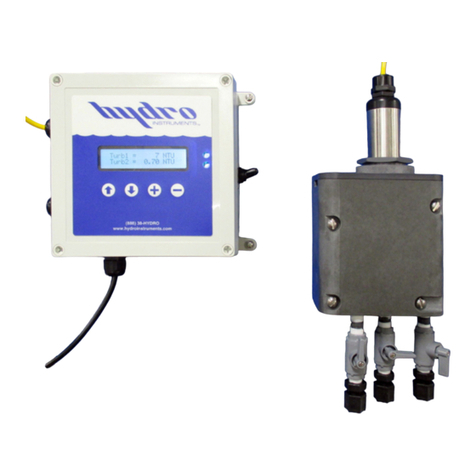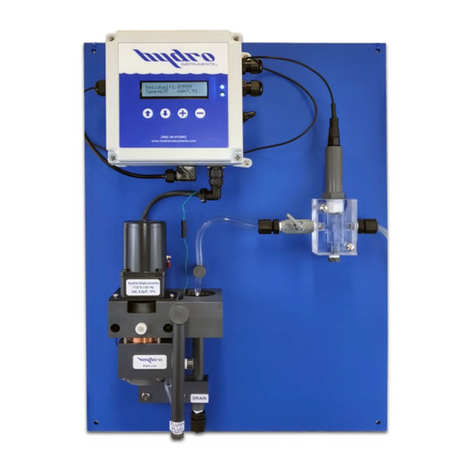
8
III. INSTALLATION
1. Sample Water Connection and Control
The residual analyzer requires a constant supply of sample water at a controlled rate and
pressure.
Flow: The sample water flow rate should be controlled at a rate appropriate for the flow
cell being used. A flow meter and rate control valve installed upstream of the analyzer
may be necessary to achieve and maintain this flow rate.
Open Flow Cell: 4 to 8 GPH (15 to 30 l/h)
Pressurized Flow Cell: 12 to 24 GPH (45 to 90 l/h)
Pressure: Where the sample point has a high water pressure, a pressure-reducing valve
must be installed to deliver the sample water to the residual analyzer. Alternatively, if the
sample point pressure is too low, then it may be necessary to use a sample pump to deliver
the sample water to the residual analyzer.
Open Flow Cell: 5 PSI (0.3 bar) max.
Pressurized Flow Cell: 15 PSI (1 bar) recommended
Other Considerations: The connection to the sample point should be made in such a way to
avoid receiving air or sediment from the pipe.
Biological growth inside the sample piping will have some disinfectant chemical demand.
This can cause measurement inaccuracies of the sample water (e.g. The chlorine residual
could decrease as the sample water passes through the sample water piping). For this
reason, it may be necessary to periodically disinfect the sample water piping to prevent
biological growth.
It is generally not recommended to use a sample water filter. As the filter collects particles
it can develop a chlorine demand causing the chlorine residual in the sample water to be
reduced, leading to inaccurate readings. However, in certain installations with significant
amounts of solids in the sample water (e.g. iron and manganese) the use of a sample water
filter may be necessary. Where a filter is necessary, it will need to be maintained frequently.
2. Sample Water Disposal
Since no reagent chemical is being injected, the disposal of the water leaving the residual
analyzer is usually not a significant concern.
3. Sample Point Location
There are at least two general concepts to consider when selecting the sample point
location. First, is to select a point that allows reliable determination of the chemical
residual concentration at the most critical point for the installation. Second, is to take into
consideration the chemical injection control timing. A balance between these considerations
must be reached.
Each system is unique, but in general the goal of the chemical injection is to achieve some
result by maintaining a chemical residual concentration in the system (e.g. To maintain a
specific chlorine residual at the exit of the drinking water facility). The location should be
selected so that the injected chemical is already fully mixed so that an accurate sample can
be sent to the residual analyzer.






























